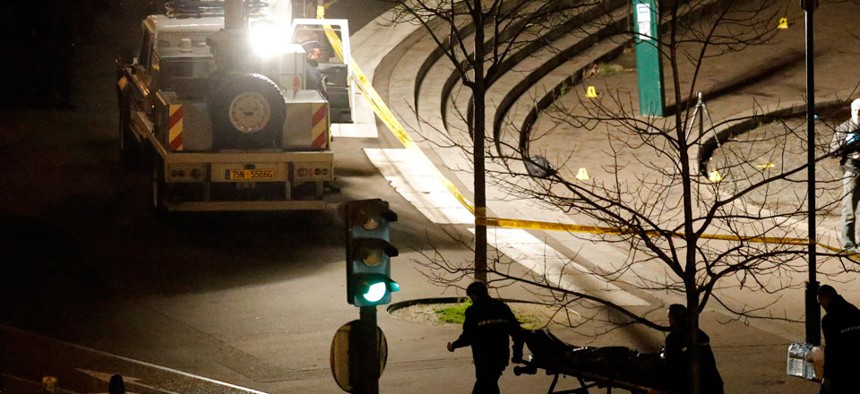Why Police Need to Hack Into CCTV Systems in Paris and Elsewhere

A body is wheeled away from a kosher grocery store which was the scene of a hostage taking in Paris, Friday, Jan. 9, 2015. Francois Mori/AP
What good are surveillance cameras populating private and public property worldwide, if emergency responders can’t immediately obtain real-time footage?
French authorities apparently initially were restricted Friday from accessing a closed-circuit surveillance system at the besieged Paris kosher supermarket. They reportedly had to “hack” the CCTV to monitor the behavior of suspected terrorist Amedy Coulibaly, who took 15 hostages and killed four people before being shot by police.
This scenario raises the question: What good are the millions of surveillance cameras populating private and public property worldwide, if emergency responders can’t immediately obtain real-time footage?
“It’s kind of surprising that they did not have some other means to get into it," said Jerry Irvine, a member of the National Cyber Security Partnership, a joint government-industry organization.
Intercepting video during a crisis situation should take minutes, at maximum, security experts say. But that's not always the case.
In the United States, locating the network and tracking down a judge to obtain a warrant are the biggest holdups, law enforcement researchers say.
Many systems are wireless, meaning technical experts merely need to crack passwords or intercept cellular data to see imagery. With older coax-cable systems, some on-the-ground tinkering could be required to get in, technologists say.
If a tenant does not provide access to the video, authorities do have to obtain a court order, but there are emergency provisions that permit them to start the interception as quickly as physically possible -- and then get the warrant over the phone.
In Paris, “obviously, there was no shortage of probable cause in this situation," said Michael German, a fellow with the Brennan Center for Justice’s Liberty and National Security Program and a former FBI agent.
Tom Bush, former assistant director of the FBI's Criminal Justice Information Services division, said: "When I had kidnapping cases, and I had to get cell phone information in real-time, you would get it, you would call up and say, 'I need it now, the paper’s coming,' and they would take care of it. When you have a life and death situation, they generally react very, very quickly.”
How to Intercept Surveillance Video
When authorities do need to break into devices, there typically are three ways of doing so, said Irvine, who also is a private consultant to state and local agencies.
With wireless surveillance systems, authorities can use a tool that mimics a telecommunications company's cell tower to trick the system into feeding footage to the cops.
When the camera is wired onsite, authorities must gain access to the physical network. It could take a few minutes to tap a connection on a different floor or plug into a switch.
For password-protected systems, the hacking could be really easy or, in very rare cases, impossible. This fall, video camera owners who neglected to change the manufacturer’s default password got a rude awakening when they saw their private feeds on the public Web. A website traced to Russia was streaming thousands of live video feeds from U.S. camera systems that lacked strong passwords.
Secure, older Wi-Fi technologies "can be hacked within 5 to 10 seconds," but "newer encrypted technologies may be uncompromisable," such as those at military facilities or banks, Irvine said.
How Not to Intercept Surveillance Video
During the 2013 Navy Yard shooting incident, where a gunman took a dozen lives before ending his own, D.C. metropolitan cops stumbled because they weren't granted access to all CCTV cameras there, according to a postmortem report.
Some of the cameras were only reachable from a room inside the facility a guard locked without telling anyone. The available video and witness statements left authorities with the false impression there might be a second shooter. The report recommended security personnel in the future regularly coordinate with one another to ensure everyone knows information-sharing procedures.
Video surveillance information-sharing, in fact, could become a significant holdup in a crisis one day, some researchers say.
"We’re paying the price for the past sins of the lack of interoperability -- the data and voice and now the same thing is true on the video," said Tom O’Reilly, executive director of the Police Institute at Rutgers University and a former Justice Department official. Police stations don't want to "have 14 or 25 different technologies to interface with 25 different standards from 25 different vendors. If they use a common standard, that is certainly more cost effective."
Government, specifically the National Institute of Standards and Technology, should step in with technical specifications to make sure all consumer systems can talk to each other in the same language, he said.
"So it’s a not tax or penalize type of thing, but it’s initially a set of common standards and then hopefully, you get the insurance industry to incentivize it," O'Reilly added.



